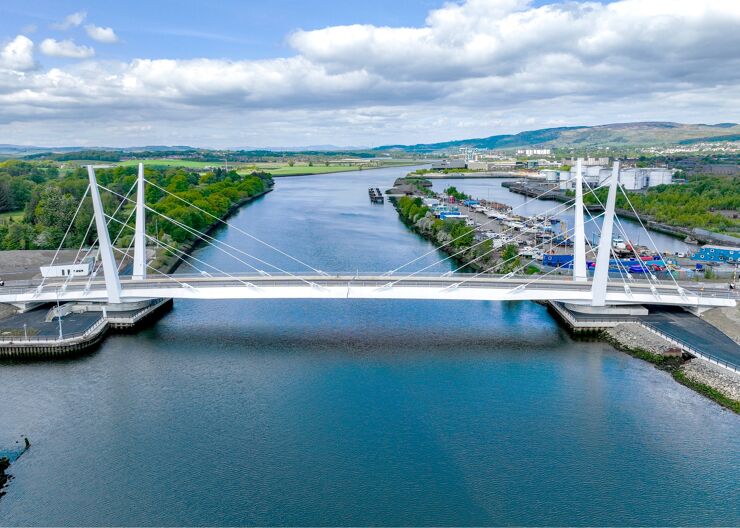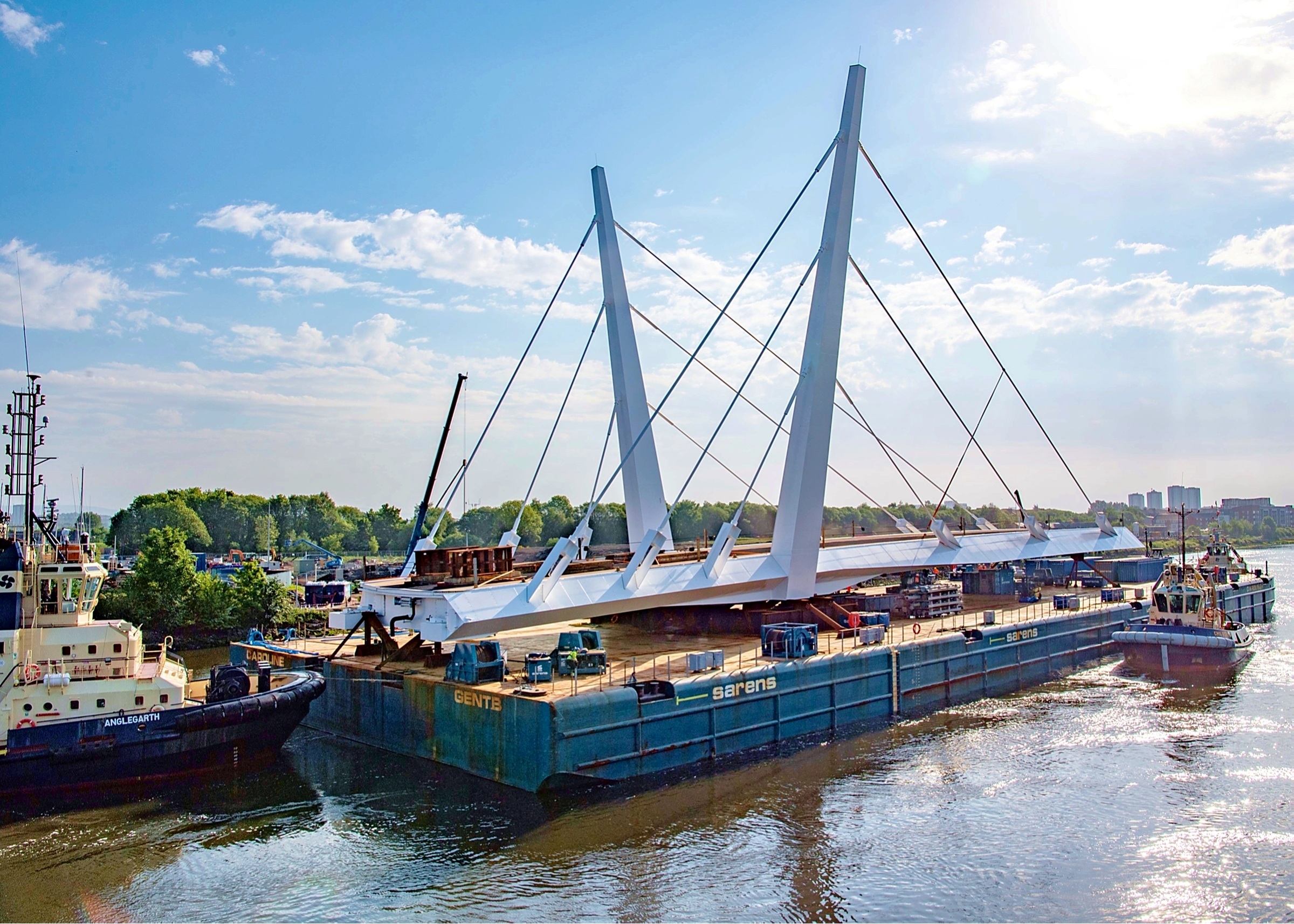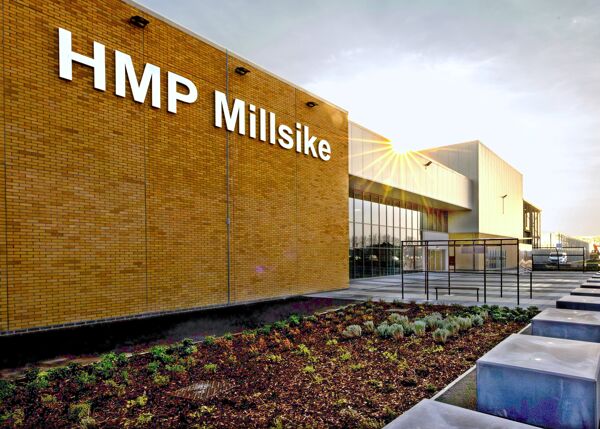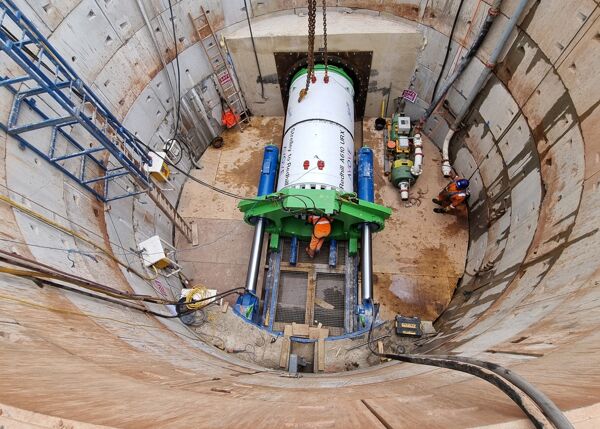
NEC has been used to deliver new infrastructure to regenerate the Clydebank waterfront and Renfrew riverside areas in Scotland, UK. Client Renfrewshire Council let the work to Graham Construction under a £96 million NEC4 Engineering and Construction Contract (ECC) Option C (target contract with activity schedule) in November 2021. The contract was completed on time and budget in April 2025.
The project centrepiece is a new two-lane road and pedestrian bridge over the tidal River Clyde, linking Renfrew in the south to Yoker and Clydebank in the north, some 8 km west of Glasgow city centre. The 184 m long crossing is the first twin-leaf cable-stayed swing bridge in the UK, with each 92 m long steel leaf pivoting horizontally to allow for river traffic. The 1,600 t south and north sections were manufactured by Hollandia Infra in the Netherlands and Smulders Iemants in Belgium respectively, and transported to Scotland on barges.
In addition to the bridge and its control building, the project included a new 750 m two-lane road to the Advanced Manufacturing Innovation District Scotland, other connecting roads, new walking and cycling routes, and landscaping. The completed scheme will help to create jobs, generate vital work for local suppliers and accelerate the local and regional economy. It has also reduced traffic congestion, shortened journey times, improved public transport reliability and enhanced air quality.
The NEC project manager was Jacobs Engineering and the designers were Ramboll (roads and substructures), Hardesty & Hannover and Roughan & O’Donovan (superstructure), Fairfield Control Systems (electrical) and Hycom (hydraulics). Each were engaged under an NEC4 Professional Service Contract (PSC), while subcontracts included a mix of NEC4 Engineering and Construction Subcontracts (ECS) and NEC4 Engineering and Construction Short Subcontracts (ECSS).
Simple collaborative contract
Renfrewshire Council programme director Barbara Walker says NEC was chosen as it provided a recognised, simple and collaborative contract. ‘NEC is readily understood by the market, ensuring that all parties involved in the delivery understood their contractual obligations from the outset.’
She says the council recognised that building the first twin-leaf cable-stay opening bridge in the UK would involve significant complexities and uncertainties during construction. ‘NEC4 ECC Option C provided the best way to create an environment where the client, project manager, contractor and designers could work closely to solve these complex design and construction challenges in a manner which benefited all parties.’
Walker says the contract was particularly beneficial in driving collaborative behaviour across the delivery team. ‘It incentivised collaboration and cost control through shared financial risk and gain. These shared financial incentives meant that the client and project manager played a much more active role in supporting the contractor with solving many of the project’s complexities.’
Flexibility and communication
 She says Option C also meant there were greater incentives to be flexible as a client. ‘This resulted in a greater number of discussions around the project scope and where requirements could be improved or were unnecessarily onerous. Fortnightly design development meetings allowed for open discussion around design requirements and issues, and these also drove strong collaboration and problem solving through sharing of experiences.’
She says Option C also meant there were greater incentives to be flexible as a client. ‘This resulted in a greater number of discussions around the project scope and where requirements could be improved or were unnecessarily onerous. Fortnightly design development meetings allowed for open discussion around design requirements and issues, and these also drove strong collaboration and problem solving through sharing of experiences.’
Walker adds that the processes inherent in the NEC contract – such as early warnings, compensation events, forecasts, programme and payments – were closely followed by all parties. ‘This meant that there was good communication throughout the construction phase and issues were dealt with efficiently. As a client, this provided greater certainty around the final project delivery, which is key to managing both internal and external stakeholders.’
Benefits of using NEC
- NEC is readily understood by the market, ensuring all parties understood their contractual obligations from the outset.
- NEC4 ECC Option C incentivised collaboration and cost control across the delivery team through shared financial risk and gain.
- NEC early warnings, compensation events, forecasts, programme and payments meant there was good communication throughout the construction phase and issues were dealt with efficiently.




